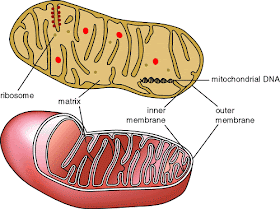
I have always found chemistry fascinating. We never did much cellular chemistry, though. But the mighty mitochondria (above) is an amazing and incredible powerhouse. It is proof of the existence of God.
As one kids' site I visited said, "Mitochondria proves there's a little bit of sunshine in everyone." And so it is. The reaction is something like this:
In plants:
sunshine + CO2 is made into sugar + O2
In animals:
sugar + O2 is made into energy + CO2
However, that reaction can also send a few extra molecules of unstable oxygen with an extra electron (O!) to prowl your blood. Those are your free radicals--and if they glom onto the wrong things, they can set off chain reactions in your cells and do some serious damage. (That process is called oxidation, or rust).
What sort of damage? Well, here's a rather technical but easy to understand explanation from this site:
As one kids' site I visited said, "Mitochondria proves there's a little bit of sunshine in everyone." And so it is. The reaction is something like this:
In plants:
sunshine + CO2 is made into sugar + O2
In animals:
sugar + O2 is made into energy + CO2
However, that reaction can also send a few extra molecules of unstable oxygen with an extra electron (O!) to prowl your blood. Those are your free radicals--and if they glom onto the wrong things, they can set off chain reactions in your cells and do some serious damage. (That process is called oxidation, or rust).
What sort of damage? Well, here's a rather technical but easy to understand explanation from this site:
Cell membranes are made of unsaturated lipids. The unsaturated lipid molecules of cell membranes are particularly susceptible to this damaging free radicals process and readily contribute to the uncontrolled chain reaction. Oxidative damage, another name for the chemical reaction that free radicals cause, can lead to a breakdown or even hardening of lipids, which makeup all cell walls. If the cell wall is hardened (lipid peroxidation) then it becomes impossible for the cell to properly get its nutrients, get signals from other cells to perform an action (such as firing of a neuron) and many other cellular activities can be affected. In addition to the cell walls, other biological molecules are also susceptible to damage, including RNA, DNA and protein enzymes.
Very scary stuff. And apparently, in the presence of heavy metals, this process explodes exponentially.
But there is hope.
If you eat a diet of foods which your body can easily convert into anti-oxidants, they rush in and partner up with the rebelling radicals and peace and love and harmony conquer all. (And I mean all: just look at the list of "problems" an extra dose of anti-oxidants can "cure".)
I need lots of anti-oxidants. I'm rusting. Really rusting. Not only did smoking introduced an enormous number of free radicals into my body (and toxins, too, of course), but I never ate very many fruits and vegetables. (For some reason, smokers don't.)
I need lots of anti-oxidants. I'm rusting. Really rusting. Not only did smoking introduced an enormous number of free radicals into my body (and toxins, too, of course), but I never ate very many fruits and vegetables. (For some reason, smokers don't.)
So, according to everyone, I should be eating foods rich in flavonoids, a veritable psychedelic cornucopia of foods. Food that is purple, food that is yellow, green food, red food, blue food. From a cursory look at the literature available on Google, it seems that supplements do not have the same impact on free radicals, True love comes from true food.
Specifically:*
1. Small red beans, dried. (huh?)
2. Wild blueberries
3. Red kidney beans
4. Pinto beans (I don't think I've had a pinto bean in my life. At least, not on purpose.)
5. Blueberries, cultivated.
6. Cranberries
7. Artichokes, cooked. (You wouldn't think of eating it raw, would you?)
8. Blackberries
9. Prunes. (I'm a fan of dried prunes, actually. I love them).
10. Raspberries
11. Strawberries
12. Red Delicious apples. (Who knew individual kinds of apples were better than others? Good grief.)
13. Granny Smith apples
14. Pecans
15. Sweet cherries
16. Black plums.
17. Russet potatoes, cooked
18. Black beans
19. Plums
20. Gala apples
* From Ultrametabolism by Dr. Mark Hyman. No idea how much nor how often. The book is a bit sketchy when it comes to that kind of detail.
Specifically:*
1. Small red beans, dried. (huh?)
2. Wild blueberries
3. Red kidney beans
4. Pinto beans (I don't think I've had a pinto bean in my life. At least, not on purpose.)
5. Blueberries, cultivated.
6. Cranberries
7. Artichokes, cooked. (You wouldn't think of eating it raw, would you?)
8. Blackberries
9. Prunes. (I'm a fan of dried prunes, actually. I love them).
10. Raspberries
11. Strawberries
12. Red Delicious apples. (Who knew individual kinds of apples were better than others? Good grief.)
13. Granny Smith apples
14. Pecans
15. Sweet cherries
16. Black plums.
17. Russet potatoes, cooked
18. Black beans
19. Plums
20. Gala apples
* From Ultrametabolism by Dr. Mark Hyman. No idea how much nor how often. The book is a bit sketchy when it comes to that kind of detail.
I forgot to list chocolate. 2-3 oz per day, as long as it is 70% cocoa. The husband just brought some home. Lindt makes some.
PS: For breakfast, I therefore had 2 tablespoons of teeny tiny chopped up pecans and 1/4 cup dried cranberries in my Red River Cereal.

No comments:
Post a Comment
Don't we all love comments? Thanks so much for taking the time to share your thoughts.